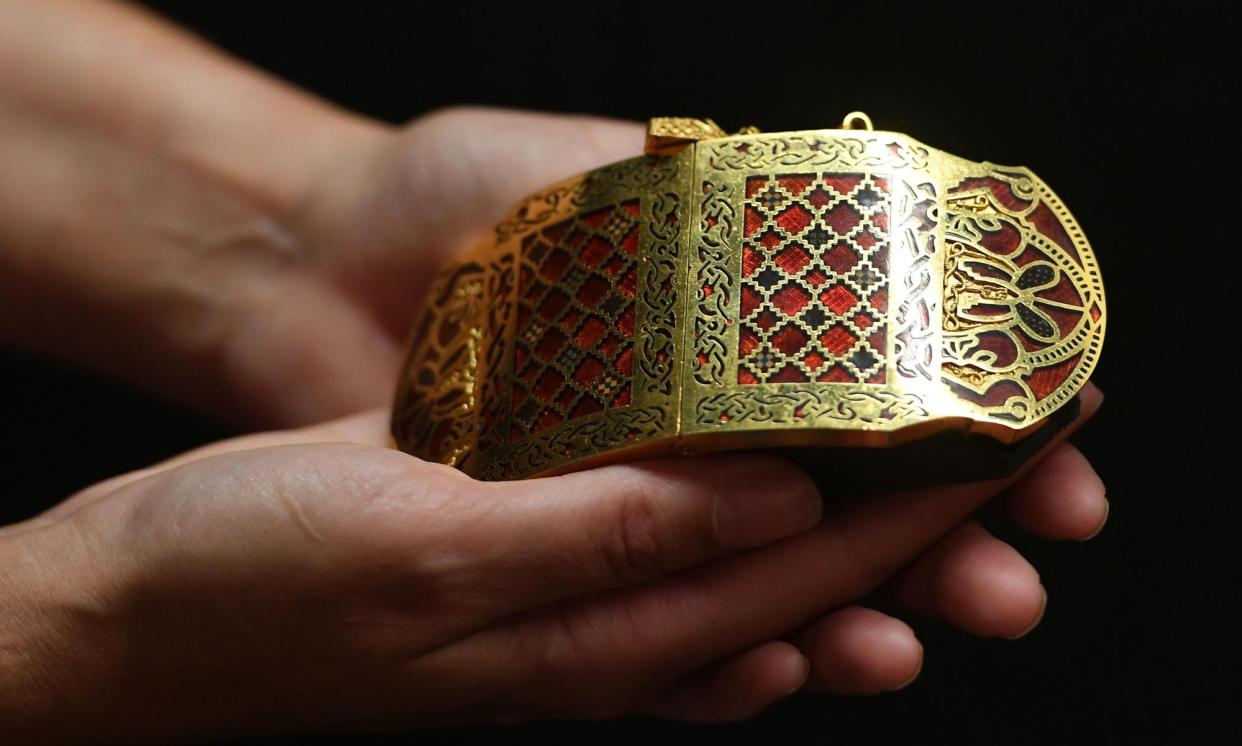Anglo-Saxons may have fought in northern Syrian wars, say experts

Sixth-century Anglo-Saxon people may have travelled from Britain to the eastern Mediterranean and northern Syria to fight in wars, researchers have suggested, casting fresh light on their princely burials.
St John Simpson, a senior British Museum curator, and Helen Gittos, an Oxford scholar, have concluded that some of the exotic items excavated at Sutton Hoo, Taplow and Prittlewell, among other sites, originated in the eastern Mediterranean and north Syria and cannot have been conventional trade goods, as others have suggested.
Simpson said that “compelling evidence” suggests the individuals buried at those sites had been involved in Byzantine military campaigns in northern Mesopotamia during the late sixth century, fighting the Sasanians, an ancient Iranian dynasty.
He noted that finds from various sites include low-value objects such as Sasanian personal seals and silver drachms, which challenge the “rather simplistic view” that everything that is non-local came to these shores through long-distance trade.
Armour and riding apparel buried with those individuals include designs of Eurasian origin and one that was widely worn in the Byzantine east and across the Sasanian empire.
Simpson said: “These finds put the Anglo-Saxon princes and their followers centre-stage in one of the last great wars of late antiquity. It takes them out of insular England into the plains of Syria and Iraq in a world of conflict and competition between the Byzantines and the Sasanians and gave those Anglo-Saxons literally a taste for something much more global than they probably could have imagined.
“It adds an international dimension to those sites. We have looked at the Anglo-Saxons in a rather insular manner.”
Simpson, the British Museum’s curator for ancient Iran and Arabia, is an archaeologist whose specialisms include the archaeology of the Sasanian empire.
He said: “We’re all used to looking at our subjects from within our own academic disciplines or within modern political borders. The important thing is spotting what looks out of place and therefore explaining what it is and how it ended up there.”
Excavations at Sutton Hoo, in Suffolk, unearthed a rich Anglo-Saxon burial within a 27-metre-long ship, one of the UK’s most spectacular archaeological discoveries. Its treasures included Byzantine silverware.
At Taplow, in Buckinghamshire, the remains of a man wearing a Eurasian-style riding jacket was among discoveries. At Prittlewell, in Essex, a burial chamber was found with a copper flagon that depicts St Sergius in a Sasanian-style roundel, among other artefacts.
Simpson said: “The pearl roundel on the Prittlewell flagon is unique and puts its iconography firmly within a Sasanian design language, suggesting that it was made farther east, in a Sasanian workshop.
“The eastern connections of the warrior tunics at Prittlewell and Taplow, coupled with the design of the shoulder clasps from Sutton Hoo, strengthen the idea that these individuals returned from Syria aligned even more closely with the late antique fashions of Byzantine-Sasanian elite warrior society.”
Discussing bitumen lumps found at Sutton Hoo, which some had assumed were connected with the ship’s caulking, he noted that the Sasanians used bitumen in the lining of pottery and that major sources came from the Middle East, while the first-century Greek physician Dioscurides wrote of its extensive medical uses, for everything from asthma to hip pain.
He said: “Scientific analysis of the [Sutton Hoo] bitumen lumps show that they come from a specific source in north-east Syria … I think that’s another item that’s been brought back with perceived or real curative power … by superstitious warriors who’ve possibly even converted to Christianity on effectively Byzantine crusades against the Sasanians.”
A pottery bottle from Sutton Hoo – the only pottery from the entire burial – has long puzzled scholars as it is unlike anything found in northern Europe. Simpson said it was typical of pottery of this period produced in northern Mesopotamia, and that he believed it contained scented oil from that region.
The evidence leads him to conclude that these Anglo-Saxon warriors had served under Tiberius II and his successor, Maurice, who recorded in his military handbook that “Britons” were good at fighting “in the woods”.
Asked why the Anglo-Saxons would have become involved in their wars, Simpson suggested “a combination of adventure and pay”. He said: “The Byzantines were recruiting across western Europe for effectively a new model mobile army.”
Gittos, a fellow and tutor in medieval history at the University of Oxford, said: “This opens up a startlingly new view on to early medieval British history.”


